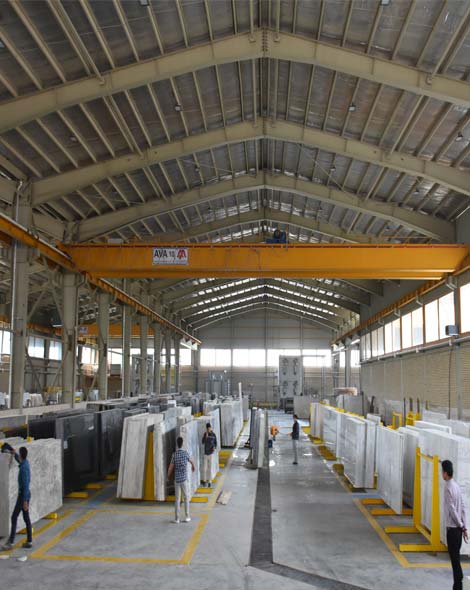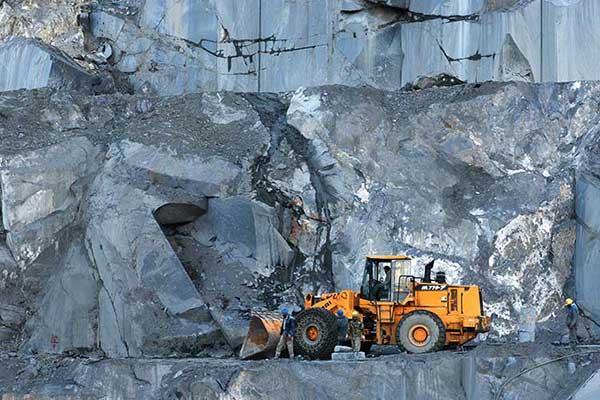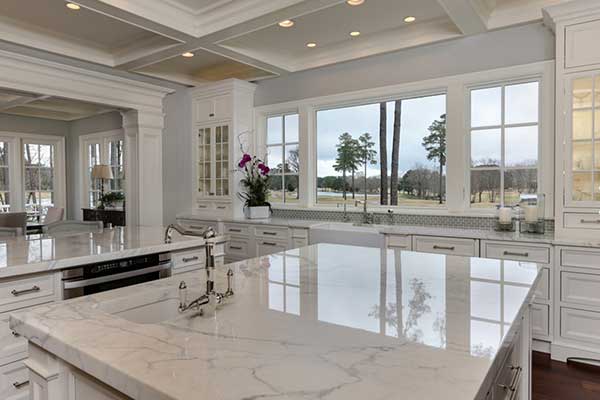What are the benefits of using porcelain stone?
What are the benefits of using porcelain stone?
Porcelain stone is in the category of metamorphic limestone and is composed of large and visible crystals. When a mass of limestone is subjected to pressure and heat, it crystallizes and transforms. The type of chemical composition and the amount of metamorphism of this rock varies according to the mineral from which it is extracted.
Porcelain is composed of minerals such as hematite, quartz, simonite, graphite and و and its main minerals are calcite and wollastonite. If the amount of quartz mineral in this rock is high, the rock will have a high hardness.
Porcelain stone is one of the practical stones in construction that is used for both the facade of the building and the interior decoration. Most people think that this stone is a product of China if this stone is extracted and exploited from the country's mines. Among the most famous mines from which this stone can be extracted are Aligudarz, Yazd, Neyriz, Sirjan and Azna Chinese stone mines.
Read more: Porcelain stone and its applications
Porcelain is a type of marble whose texture is crystalline. This stone is processed with low thickness for various uses. The strength of this stone is very high and even if its thickness is low, it will have a high compressive strength. The porcelain stones that are marketed are often white and without veins, and their crystalline type has fine crystals.
Crystalline stones are used to make building decorations and stone sculptures. These stones have a representative and unique glare and are always considered by architects and building designers.
This stone is also known as crystal stone and is used in most parts of the building from wet to dry places due to its extraordinary strength and durability. The most common use of porcelain stone is for building facades. This stone has a high resistance to water penetration, so it is used in centers and health services that need cleanliness and cleanliness. In addition, it can be used to build street table blocks.
Chinese stone color
The color of porcelain stone is pure white and crystalline, but it is also found in other colors such as light gray to dark gray, green, pink, red, yellow and cream. The main reason for this coloration is the presence of various minerals in the rock. The presence of carbon in these rocks makes them dark and light gray in color, and chlorite and various silicates lead to green spectra in them. In addition, creamy yellow limonite and manganese carbonate or hematite give the stone a red or pink color. In hot areas, light porcelain stone is mainly used to show the building, because this stone prevents heat absorption and keeps the building cool.
Advantages of Chinese stone
Porcelain stone has a high resistance to surface and deep weathering, so it can be used with ease in the facade of the building. This stone absorbs a small amount of heat due to its light color, therefore It is a cool stone.
Crystal rock, as its name implies, has crystalline particles and transmits light. This type of rock is resistant to water penetration due to its very low porosity and is not damaged even if it is exposed to water for a long time. Compressive strength, strength and longevity of this stone is high and does not crack against impact. Diverse and beautiful color spectrum of this product completes the design of construction projects.
This stone has the ability to engrave and various patterns and drawings can be performed on it.
Click to consult and buy with Uranus Stone Industries.
The difference between porcelain stone and marble
The difference between porcelain stone and marble
There are differences between porcelain stone and marble, which may be difficult for those who are not fully acquainted with this industry to distinguish between the two. In this article, we are going to acquaint you with the differences between these two stones.
Marble is a type of sedimentary limestone, while marble is a type of limestone resulting from metamorphism. Commercially, the Chinese are called white sugar stones, which have a very high hardness, but scientifically, porcelain or crystal stone is a limestone that recrystallizes due to increased heat flux due to the injection of hot magma or high pressure. Have been referred to
Read more: Using porcelain stone on the parking lot floor
The difference between porcelain and marble in terms of geology
So marble is not necessarily the same as aragonite. Geologically, marble is called metamorphic limestone and is called Marble and Onyx, but commercially, it is called marble and marble and is a combination of metamorphic or non-metallic limestone and dolomite.
Coarse-grained, white or light gray to cream marble is called porcelain. Marble stones are mainly known for use in parts such as the interior of the building, and their prominent characteristics include the variety of colors. Of course, in between, we have porcelain and crystal stones, which are sometimes referred to as the same, and for example, they are also called crystal porcelain.
The use of porcelain stone for facades and outdoor spaces is completely technical and correct
Marble in indoor environments have a higher durability and durability than open spaces, but porcelain is completely technical and correct for facades and outdoor spaces. Chinese resistance to surface and deep weathering is moderately good and remarkable.
Color difference between porcelain stone and crystal stone
The color of the crystal is generally dark to light gray with gray, black, and yellow streaks. And marble in various types
Yarns are produced and processed in Iran. Marble is used in the body of stairs, parking lots, floors of buildings and porcelain in the facades of buildings - stairs - paving - sidewalks - stone tables, stone artifacts, etc. goes.
Click to view the gallery of porcelain stone and marble of Uranus Stone Industries.
What is granite?
What is granite?
Granite is derived from the word "granum" and is usually composed of quartz, mica, feldspar. The texture of this stone is in the form of grains that these grains may sometimes be microscopic and sometimes their dimensions reach even a few centimeters and a few meters. This rock is usually formed in the Earth's crust due to the cooling of molten material, but the cooling process of these rocks is slow and for this reason we see a special hand in their grain texture and like other volcanic rocks We do not see them as sponges.
Granite and its types
In general, granite is observed and classified into three categories. Granite rocks that were formed about two million years ago, which is called the pre-geological period, were formed. These stones can not be used as decorative stones because they were formed during the Earth's orogeny.
In principle, the granites that are used for building work and are aesthetically valuable are related to the Mesozoic and Cenozoic periods in geology. Since granite rocks have different appearance depending on the time and conditions and place of their formation. , The main color that is considered for it is the color of its paste or in other words the color of the majority of its elements.
What are the elements of granite?
The chemical composition of granites consists mostly of silicon and aluminum, which make up about 85% of the composition of granites, and the remaining 15% are elements such as: titanium, iron, calcium, magnesium, sodium and potassium.
The main minerals forming granite
Granite is composed of the main minerals which are: quartz, plagioclase, potassium feldspar and other dark minerals. The amount of these minerals in granite determines the name of granite rocks. Also, sometimes other minerals such as pyrite, hematite, mannite and ilmenite are found in granite rocks. In the following, we will explain the granites that have been identified with other names due to the presence of more or less percentage of minerals. :
Granophytic granite rocks: This type of granite has fine grains of crystals that are made of quartz and feldspar that these fine grains have grown inside each other and have formed this type of granite.
Aplite granite rocks: This type of granite is composed only of quartz and feldspar and is likely to be a very small amount of mafic minerals, the texture of this granite is called apilite.
Pegmatite granite rocks: This type of granite has a coarse grain texture.
Of course, it must be said that some granites may be metallic minerals such as mercury, manganese, magnetite, copper, gold and silver.
Granite rocks and their texture
The texture of granites is granular and these grains are spread from medium to large on the surface of granite rocks and are usually semi-shaped. (That is, they appear to be in a state of existence and disappearance). Coarse grains of potassium feldspar crystals are found in granites called porphyry textures.
Also, in some granites, very fine minerals such as apatite and sphene are found in very small sizes. Of course, there is another category for the texture of granites, which is called block, mass and rubble, as well as one of the textures. Very common in granites Granular texture that this type of texture can be seen in the form of fine to large grains in ceramics.
Marble and its types in the Iranian market
Marble and its types in the Iranian market
Marble is a type of metamorphic rock based on calcium carbonate that is composed of calcite, dolomite and crystals that have long been used in the construction of buildings in Rome, Greece and other parts of the world. Its unique appearance, which includes waves with different designs and sometimes in various and beautiful colors, makes it a suitable option for many uses and satisfies different tastes according to its wide range of types.
At present, the main use of marble due to its characteristics is more specific to the building and for use in the floor, which is very popular in the Iranian market, Khoy marble is one of these choices that is used for flooring. Granite is weaker and harder than travertine.
There is a possibility of scratches on the surface of marble stones and this point should be considered in determining the place of use. This stone is also vulnerable to acid, despite its reliability against moisture, if the stone is exposed for a long time, it will change and erode.
Due to these cases, its use in areas and spaces that are constantly exposed to moisture and atmospheric factors is not recommended, except with special considerations of storage and optimal physical conditions of the stone used. One of the important points is to protect the back of the stone against moisture and also to remove impurities from the surface of the marble stones, which should be considered.
Types of marble
Hersin marble: is a type of metamorphic stone that is formed by the recrystallization of limestone. Hersin marble is one of the valuable stones among building stones due to its beauty, strength and resistance to fire and erosion.
Khoy Marble: Part of the marble
The most common marble stones are in the country market and its mine is located in Khoy, Azerbaijan. One of the good features of Khoy marble is the durability of this stone and it is such that its texture is very compact, as a result, it has a high resistance and has a relatively high price due to its high quality.
Kashmar marble: Kashmar marble mine is located in Kashmar city of Khorasan Razavi. Kashmar marble is processed in different dimensions. This stone is one of the white marbles and has been considered by the builders due to its special and bright color. Kashmar marble has two designs: full line and low line. The crystal lines and deer antlers in Kashmar marble are variable.
Click here to view and buy different types of building stones
Abadeh Marble: Abadeh Marble Mines are located in Abarkooh region of Yazd province. Abadeh Marble is one of the bright marble stones with a reasonable price. It is suitable for running in the body of stairs and the floor of the stairs and the floor of the residential space.
Mahkam Marble: It has a dark brown to light brown color and sometimes the tip of a pencil that is surrounded by spider veins and has made this stone attractive. Mahkam stone has low water absorption and high abrasion resistance. Mahkam marble is processed in tile and slab dimensions. Substantiality, transparency, design and beautiful role of Mahkam marble have always been considered by architects and architect designers. Mahkam stone is also known as Diamond stone in the market.
Dehbid marble: It is one of the marbles that has various uses in the building because Dehbid stone has a warm and gentle color and good quality and this stone is known as one of the best cream and bone marble stones in the world and is world famous. Dehbid stone has different types that have light cream to beige colors and is very popular among interior decoration designers and employers due to its stunning beauty and high quality.
Read more: Porcelain stone and its applications
Golden Black marble: Golden Black marble mines in different parts of the country, including the cities of Mahallat, Kashan and Yazd. Golden Black marble has a black background or pencil tip with gold lines and sometimes white on it, a special and beautiful effect to this stone. Golden Black marble is one of the most widely used building stones, but it is not used outdoors in construction projects because it loses its calcareous veins over time due to cold and rain.
Kermanshah Cappuccino: It is a marble with a cream-beige background in which yellow and pink flowers are scattered. The design of this stone is like a cup of cappuccino with the same color combination of white and light brown. This stone has been very welcomed by domestic and foreign customers due to its special color and warmth composition. Cappuccino marble has good abrasion resistance and has a low water absorption percentage. In the production process of this stone, resin and epoxy are used to increase the gloss of the stone. If you use quality polishers when sub-stone, cappuccino marble will have a good polish.
Learn more: Using porcelain stone on the floor
Peacock marble: It is very popular due to its reasonable price and popular color. For this reason, many builders of medium-sized buildings welcome peacock-filled marble. Peacock-filled marble has cream and floral olive colors.
Sabzevar marble: It has a light white color and several varieties of this stone such as beige, cream and gray are extracted. Sabzevar marble is processed in slab and tile dimensions. This stone has good sand resistance and epoxy and resin are used to strengthen this stone. Sabzevar white marble is priced depending on the color and type of processing.
Bastam marble: It has a light cream to dark cream background that has super and excellent degrees of light and caramel color, but lower degrees of brown halos and black spots can be seen in it. Bastam marble is generally used in paving and interior facades of buildings. This stone gives a special splendor and warmth to your building and Bastam marble can be used in all interior parts of the building. One of the most important applications of Bastam marble is its use as a floor stone.
Read more: Benefits of using Chinese stone
Semirom Marble: It is an old building stone that has been used in the construction industry in the building. My stone is processed in the form of sand, my ax is processed, and my stone is processed into leather. Semirom stone is used more in the inner and outer walls of the building due to high water absorption and low compressive and abrasion resistance, and less is used in paving.
In recent years, due to the high price of travertine stone, especially light and white travertine stones, Semirom stone has become a suitable option for builders and architects. Semirom leather has a texture similar to leather travertine and is especially used in walls and interior facades of buildings.
And other types of this stone ....
Comparison of marble and porcelain
Marble is weaker in resistance to granite and harder than travertine. There is a possibility of scratches on the surface of the marble and this point should be considered in determining the place of use.
This stone is vulnerable to acid, despite its resistance to moisture, but with prolonged exposure, this stone undergoes changes and erosion. Due to these cases, its use in areas and spaces that are constantly exposed to moisture and atmospheric factors is not recommended, except with special considerations of storage and optimal physical conditions of the stone used. One of the important points is to protect the back of the stone against moisture and also clean it
Debris is from the surface of the marble that must be considered.
Marble
مرمریت
Marble
Marble
Marble Stone
Granite
Granite
Granite Stone
Chinese
Chinese rock
Chinese stone
Isfahan marble
Isfahan granite
Isfahan Chinese Sanp
Travertine
Travertine
Travertine stone
Isfahan travertine stone
Stone view
Building stone
Stone facade
Stone facade
Stone cleaning
Artificial stones
Natural stones
Interior decoration
Cleaning the stone
Crystal
Dolomite
Calcite
Quartz
Graphite
Hematite
Simonite
پریت
Manganese carbonate
Lemonite
Stone resistance
Natural stone
Artificial Stone
Stone flooring
Marble of the Emperor
Dehbid cream marble
Dehbid marble
Persian Rose Marble
Persian Marble
Persian Rose Stone
Marshall Black Marble
Marshall Marble
Black marble
Marshall Black Stone
Black Marshall Marble






.jpg)
.jpg)
.jpg)
.jpg)


















